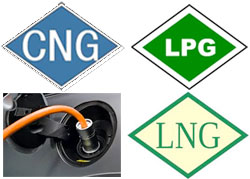Alternate Fuels |
Facilities Modification for Natural Gas Vehicles
by Leo Thomason, Executive Director, Natural Gas Vehicle Institute (NGVi)
As sweeper fleet managers, vehicle dealers and distributors and other service providers ramp up to begin more widespread maintenance and repair of natural gas vehicles, their first priority must be to ensure the health and safety of employees and customers alike.This article is also available in Adobe's PDF file format. To download or view the PDF, click here. This is accomplished by making certain vehicle facilities meet the code and safety requirements for maintaining and repairing NGVs. This is especially important because natural gas is a lighter-than-air fuel – which is totally opposite of the properties for gasoline or diesel. Why Are NGV Maintenance Facilities Modifications Necessary?Existing vehicle maintenance or repair facilities have been designed to meet safety code requirements for gasoline and/or diesel, and both the liquid and the vapors for these fuels are heavier than air. Thus, the code requirements address the needs of heavier-than-air fuels. Natural gas, on the other hand, is lighter-than-air and is stored onboard vehicles at high pressures. Facilities that were originally designed for heavier-than-air fuels must be modified if lighter-than-air fueled vehicles will be repaired. Think about it – if diesel or gasoline spill, the dangerous or "classified" area where a fire might ignite is on the ground and 18 inches up. However, because natural gas is lighter than air, it rises when leaked—and the potentially hazardous area in a maintenance facility becomes from the ceiling 18 inches down. What's usually located within that 18-inch area? Lights, electric motors, conduits, heaters – all of these are potential ignition sources for natural gas and must be dealt with by making appropriate modifications. What Codes Are Involved for NGV Maintenance Facilities?While there may be others that must be considered due to specific structural or other circumstances, there are six primary codes covering vehicle maintenance facilities including:
The final determination of which codes apply to maintenance facilities will ultimately lie with the Authority Having Jurisdiction (AHJ), which is usually the fire marshal. These codes address the lighting, heating, ventilation, and internal building structural systems of vehicle maintenance facilities for natural gas vehicles. The codes were developed over a period of three decades, and are performance documents – not design documents. Interpreting the codes requires expert evaluation of potentially hazardous conditions – the most prevalent of which is the unintentional release and ignition of natural gas while it is inside a maintenance facility. Because each maintenance facility is different, the codes must be applied based on the unique characteristics of each facility. This sounds relatively simple – but it is not – partly some of the codes conflict. For example, on the subject of ventilation in pits, there is a discrepancy between what is required in the International Fire Code and the National Fire Protection Association Code 52. Major vs. Minor Repair FacilitiesThe International Fire Code (IFC) defines a major repair facility as one where work is performed on the fuel system and may require open flames or welding. On the other hand, a minor repair facility is defined as one where work is not performed on the fuel system and is limited to exchange of parts and maintenance requiring no open flame or welding. The fuel system is defined as any component located between the fuel receptacle and the fuel injector. Both the IFC and NFPA 30A exempt minor repair facilities from all code requirements specific to CNG and LNG – except for ventilation requirements. By code definition, minor repair facilities perform services including:
All other work involving the fuel system is considered major repair, including changing coalescing filters. To minimize costs, some (but not all) facilities can be separated into major and minor repair areas. Separation can be accomplished through the use of fire walls, partitions and other methods—all of which must be pre-approved by the AHJ. What Is Included in an Effective NGV Maintenance Facility Evaluation?To ensure safety and code compliance, a comprehensive vehicle maintenance facility evaluation must be performed by an expert in appropriate CNG code requirements, interpretations and industry best practices. These evaluations include the following:
Maintenance facility evaluations for most maintenance and repair facilities take about one day to complete plus appropriate time (usually one to two days) for researching additional codes if necessary and writing a comprehensive report of findings and recommendations. What Happens After the NGV Maintenance Facility Evaluation is Completed?Once the report is written and depending on the recommended modifications, next steps may include:
How Much Do NGV Facilities Modifications Cost?Because every facility is different, costs vary depending on the size of the facility and the modifications that must be undertaken. It's worth noting that there can be a huge cost difference between making the reasonable modifications that are required by code vs. "gold plating" (making every modification possible). The codes are designed to ensure safety—and going beyond them is not necessary. If you would like to discuss your need for vehicle maintenance facility evaluations, please contact NGVi Customer Service at info@ngvi.com, or by calling 800-510-6484. |
© 2005 - 2021 World Sweeper
|
Return to Alternate Fuels Home Page:
|